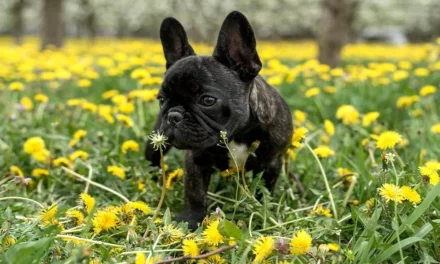Why Are French Bulldogs Tails Docked?

Have you ever wondered if French Bulldogs enter the world with long, beautiful tails only to have them cruelly snipped away for cosmetic reasons?
It’s distressing to even imagine such a fate for these beloved companions. But here’s the heartening truth: French Bulldogs aren’t subjected to tail docking or having their tails cut off at birth.
In fact, they come into this world without long tails; instead, they sport adorable, naturally short and distinctive tails.
In this article, we’ll delve into the reasons behind the naturally short tails of French Bulldogs and explore whether this trait poses any health concerns or challenges for this beloved breed.
Unveiling the Short Tails of French Bulldogs:

Origins and Evolution
French Bulldogs possess naturally short tails due to a genetic mutation that emerged during the breed’s evolution in the 19th century.
The breed’s lineage traces back to selective breeding practices involving English Bulldogs, leading to the manifestation of this distinctive genetic trait affecting the tailbone’s development.
- Genetic Mutation and Origins:
- French Bulldogs possess naturally short tails due to a genetic mutation that emerged during the breed’s evolution in the 19th century.
- The breed’s lineage originated from selective breeding practices involving English Bulldogs, leading to the manifestation of this distinctive genetic trait affecting the tailbone’s development.
- Evolution of Tail Length:
- Historical photographs show that Frenchies previously had longer tails, which gradually shortened over time.
- The reduction in tail length could be traced back to the breed’s original purpose of ratting.
- Ratting and Tail Length:
- Selective breeding aimed at enhancing the breed’s efficiency in ratting might have contributed to the gradual shortening of their tails.
- Shorter tails potentially provided advantages such as increased agility and minimized susceptibility to tail injuries from rat bites, aligning with their role as working dogs.
- Transition to Companion Dogs:
- As French Bulldogs transitioned from working roles to beloved companions, the shortened tail became a characteristic feature due to selective breeding for aesthetic preferences.
- Despite their domestication, some modern Frenchies still exhibit traits associated with their rat-catching lineage, displaying strong instincts for rat-catching even in today’s settings.
These points highlight the genetic basis, historical evolution, functional advantages, and the transition of French Bulldogs’ tail length from their working origins to a desired aesthetic trait in the breed’s development.
Ethical Considerations: Questioning the Necessity

Is tail docking truly necessary for French Bulldogs?
The ongoing discourse surrounding the ethical implications of tail docking prompts a fundamental inquiry: Is this practice genuinely essential for the well-being of French Bulldogs?
Exploring Alternatives: Prioritizing Well-being
What are the viable alternatives to tail docking?
In advocating against the necessity of tail docking, numerous alternatives stand as viable options, placing the well-being of French Bulldogs at the forefront.
Comprehensive Training Programs
How can training programs contribute as an alternative?
Investing in comprehensive training programs emerges as a proactive measure to foster responsible ownership and prevent tail injuries without resorting to surgical alterations.
Environmental Adjustments: Creating Safe Spaces
How do environmental adjustments contribute to preventing tail injuries?
Strategic environmental adjustments are key to minimizing potential hazards and creating safe, dog-friendly spaces that reduce the risk of accidental tail injuries.
Heightened Awareness of Behavioral Cues
How does increased awareness of behavioral cues help in preventing tail injuries?
Enhanced awareness of a French Bulldog’s behavior empowers owners to recognize signs of distress, enabling timely interventions to prevent situations that may lead to tail injuries.
These alternative approaches prioritize the well-being of French Bulldogs while steering away from invasive procedures like tail docking, highlighting ethical considerations and more humane strategies for their care.
French Bulldog Tail Problems

French Bulldogs are adorable and lively companions, but they can encounter various tail-related health issues. These problems primarily encompass infections, spinal deformities, and susceptibility to sunburn.
1 – Tail Pocket Infections
One common concern is tail pocket infections, particularly in French Bulldogs with screw tails. These tails, due to their twisted nature, predispose these dogs to infections within the tail pocket—a hidden skin fold that is challenging to keep clean. This vulnerability makes the area prone to gathering dirt and substances, leading to irritation and subsequent infections.
Symptoms of Tail Infection:
- Itching and redness in the affected area.
- Unpleasant odor due to the presence of pus and dead skin.
Treatment for Tail Infection:
- Start by cleansing the area with warm water and antiseptic soap to eliminate dirt.
- Use antiseptic spray or wipes followed by gentle drying with a clean gauze.
- Application of a soothing cream or coconut oil can aid healing and alleviate skin irritation.
- If the infection worsens, seek immediate veterinary assistance.
Preventing Tail Infections:
- Regularly trim the hair around the tail.
- Clean the tail wrinkles and pocket using dog grooming wipes for effective maintenance.
- Apply coconut oil to prevent skin irritation, itchiness, and dryness.
2 – Tail Deformities: Hemivertebrae
French Bulldogs are susceptible to tail deformities, primarily hemivertebrae. This condition involves abnormally shaped vertebrae in the tail, leading to misalignment and potential spinal issues, commonly seen in dogs with screw tails.
Symptoms of Hemivertebrae:
- Tail pain.
- Wobbliness and hind leg function loss.
- Severe cases may involve loss of bladder and bowel control.
Treatment for Tail Deformities (Hemivertebrae):
- Mild cases usually receive anti-inflammatory medications.
- Severe cases necessitate Hemilaminectomy surgery to alleviate pressure on the spinal cord, with costs ranging from $1500 to $4000.
Preventing Tail Deformities:
- Responsible breeding practices, adhering to breed standards, can mitigate the risk of genetic malformations.
3 – Sunburn
Surprisingly, French Bulldogs are susceptible to sunburn, especially with prolonged exposure to direct sunlight. Their short fine hair and pink skin, including their tail area, make them vulnerable to sun damage.
Sunburn Symptoms:
- Red or pink skin.
- Sensitivity to touch.
- Peeling skin or blisters.
Treatment for Sunburn:
- Veterinary examination to determine severity and proper treatment, including fluid provision for heat exhaustion and dehydration.
- Application of cold compresses and cortisone ointment to alleviate pain and aid healing.
Preventing Sunburn:
- Limit exposure to direct sunlight, especially during peak hours.
- Provide shaded areas using parasols or elevated dog canopies.
- Avoid strong sun rays by keeping dogs indoors during midday.
- Consult with a vet for safe sunscreen options and potential risks associated with ingestion.
These precautions and awareness of these common French Bulldog tail problems can help owners safeguard their furry companions’ well-being.
Common Myths and Misconceptions

Does tail docking prevent future health issues?
Contrary to popular belief, tail docking doesn’t necessarily prevent health issues and is not a guarantee against tail-related problems.
Is tail docking beneficial for the dog’s appearance?
While some argue that docked tails enhance the breed’s appearance, others believe that a natural tail complements the dog’s overall aesthetics.

In conclusion, tail docking remains a debatable practice in the realm of French Bulldog care.
While it has historical roots and is still prevalent in some regions due to breed standards, it has sparked controversies regarding its necessity and ethical implications.
Understanding the reasons behind tail docking allows prospective dog owners to make informed decisions based on the best interests of their furry companions.
As attitudes toward animal welfare evolve, it’s essential to consider alternatives that prioritize the health and well-being of French Bulldogs without subjecting them to unnecessary procedures like tail docking.




